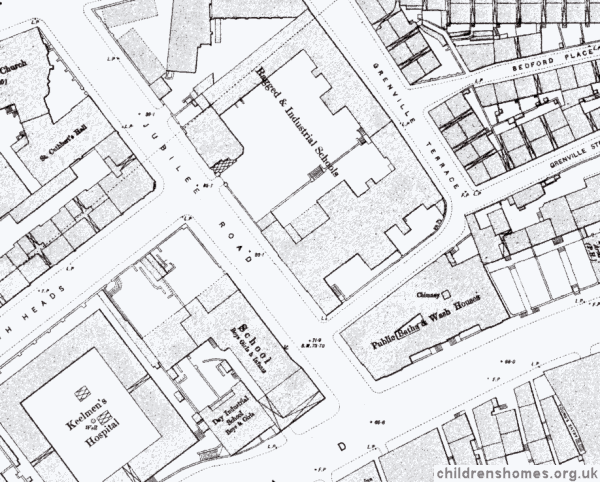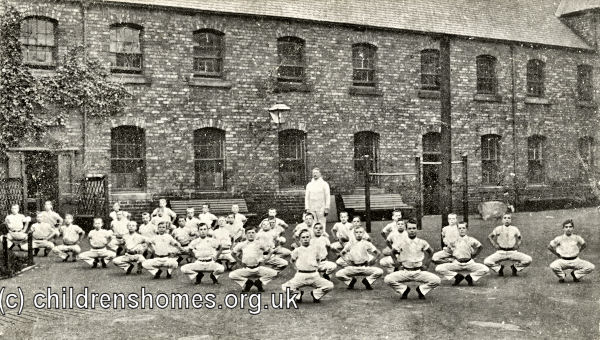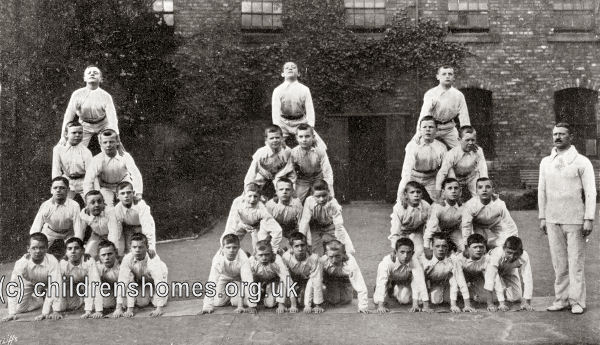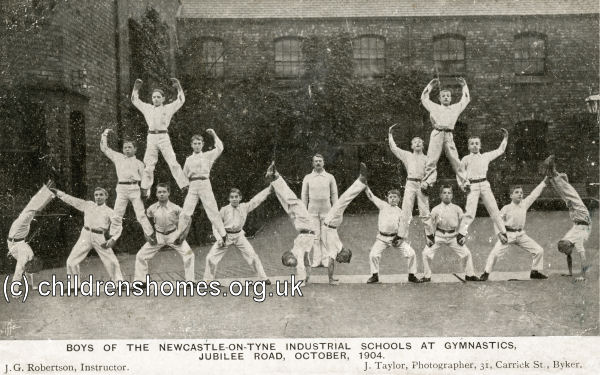Ragged and Industrial Schools, Newcastle upon Tyne, Northumberland
The Newcastle upon Tyne Ragged and Industrial School was founded following a meting of interested individuals on July 2nd, 1847, when it was it was resolved to open such an establishment at the east end of Sandgate, for the education of boys. The instruction was to comprise reading, writing, arithmetic, and a knowledge of the Holy Scriptures. As an inducement to attend the school, and also with view of lessening the temptation to beg or steal, each child was to be presented with a penny loaf of bread daily.
A contemporary report described Sandgate as a locality which 'for filth, disease, and immorality of every description, has no equal England, or in the world. It pre-eminently conspicuous for everything low, debasing, and wretched. The very atmosphere breathes pollution and death. Misery and indigence seem stamped every countenance you meet with. Crime and immorality exercise an unbridled sway in nearly every house or hovel, and the miserable inhabitants appear to be sunk in penury, wickedness, and vice.'
The School opened on 11th August in a room at the Head of Wide-open, Sandgate. It was reported that out of the 24 boys received on the opening day, only one had shoes and stockings. The average attendance at the School was about forty boys. In December, 1847, it was reported that the older boys had begun making match-boxes for lucifers, and the younger ones were teazing hair for coach-builders, both activities generating a small income for the institution. The boys were said to be generally well behaved. Occasionally, when there were signs of disorder, a tune was started by the master, and the school was soon 'vocal with rude melody'. In order to compensate for the work done by the boys, an additional meal was provided, bread and milk being given in the morning, and the usual bread and cheese at noon. It was proposed to substitute soup for the cheese when soup-kitchens were opened. Sandgate, however, lived up to its unhealthy reputation. On January 21st, 1848, the School's first master, James Murray, died from typhus fever, possibly contracted after visiting absent or sick pupils in their homes. Murray's successor also succumbed to the disease and it was decided to move the School to a cleaner and healthier situation. New premises were found in the old chapel on Gibson Street where the number of boys in attendance increased to about eighty. 1849, a Girls' School was opened in the same building.
On July 25th, 1854, the foundation stone of a new building for the School was laid by the Mayor, Ralph Dodds, Esquire. It was located on what became became Jubilee Road at Garth Heads, near the Jubilee School and the Corporation Baths and Wash-houses, although its address is sometimes given as New Road (now City Road). The ceremony was attended by a large crowd, which included the ragged school boys and girls who sang some suitable hymns and other pieces. Mr. W.J. Slowan, one of the honorary secretaries, deposited in the foundation stone a bottle, containing a complete series of the reports of the institution; a copy of the programme of the recently held bazaar, by which the most of the building funds had been raised; a set of silver coins of the present reign; and a document bearing the words, 'The foundation stone of this building, intended as a Ragged and Industrial School, was laid by the Right Worshipful the Mayor of Newcastle (Ralph Dodds, Esq.) this 25th day of July. 1854, being the eighteenth year of the reign of our most gracious Majesty Queen Victoria.—John Dobson, Esq. architect. Trustees : George Atley Brumell, Alexander R. Dobson, Charles Frederick Hamond, William Henry Holmes, Charles John Lamb, Henry Richardson, Wm. John Slowan.'
The new building was a plain, brick-built structure. With the exception of the masters' house which was three storeys high, with the children's dormitories on its upper floors, the building was one storey in height. The design included a Boys' school-room, 53 ft. 6in. by 18ft. 6in.; a boys' work-room, 37ft. by 28ft. 5in.; boys' class room, 19ft. 7in. by 16ft,; girls' schoolroom, 53ft. 6in.by 18ft. 6in.; girls' work-room, 30ft. 6in. by 28ft. 6in.; two baths and wash-rooms, 18ft. by 6ft.; and a committee room 15ft. 6in. by 11ft. The cost of the building was £2,500, with the site having been provided by the Newcastle Corporation. The new Ragged and Industrial Schools were formally opened by the Mayor on January 24th, 1855.
The building was enlarged in 1859, and on June 3rd of that year, part of the premises were certified for use as an Industrial School, allowing it to receive children placed under detention by magistrates. Its certificate allowed for the accommodation of 125 boys and 50 girls.
In 1865, the superintendent was Mr Morgan, with Mrs Hedward as matron. A report in that year noted that the industrial employment of the boys included mat-making, tailoring, and coir picking. The older girls were trained in housework, cooking, washing etc. The average number of children attending the school in the year was, boys 113, girls 91. The number under detention on December 31st was, boys 46, girls 31.
By July 1867, there were 150 boys and 120 girls on the register of the ragged school. Of these, 48 boys and 28 girls, certified by the magistrates as destitute, were received into the institution, where they were fed, clothed, lodged, and educated; and about sixty receive their food and education; the remainder were educated and partially fed.
Also in 1867, plans were now drawn up to further enlarge the premises. At that time, the north side of the buildings contained the work rooms, with sleeping apartments above; the east side had a large shed, used by the scholars as a playground when the weather was bad; the south side contained the large dining hall, school rooms, and offices of the institution; the west side was allotted to the master's residence. The enlargement scheme involved removing the shed on the east side the building and replacing it with a new block which was to be named the Brummel wing, after the chief promoter of the improvements. It contained a schoolroom for the boys, with class-room adjoining, and a dormitory and reading room above for the use of the boys in the evening. The schoolroom formerly used by the boys was now added to the girls' schoolroom. The lavatories, closets and laundry were also greatly improved.
The School site is shown on the 1896 map below.

Ragged and Industrial Schools site, Newcastle upon Tyne, c.1896
In 1869, it was reported that the directors of the School had been obliged to ask for Mr Morgan's resignation. Mr Ralph Willoughby was then appointed superintendent of the School, with Miss Baxter as matron. The other staff comprised the schoolmaster, Mr. Rowley; schoolmistress, Miss Dodd, and two assistants; work-master, warden, tailor, printer, and two female assistants. The industrial employment of the boys now included hair-picking, mat and sack making, printing, and tailoring. The girls were trained for domestic employment and occupied in laundry work, housework, and in cooking the food. They were all taught plain sewing and knitting.
Mrs Rutherford took over as matron in 1872. In 1873, further extensive additions were made to the premises including a new sick room and bath room, new tailor's shop, improvements in the kitchen, laundry, wash-house and lavatories. Despite these changes, the space allotted to the girls was described by in an inspection report as being cramped and confined, with a separate establishment for them much to be desired. A general lack of order on the girls' side had resulted in a change in the staff, and a new matron, Miss James, was appointed. She was succeeded by Miss Brough 1877.
In about 1880, the School acquired a house at Whitley-on-the-Sea with 12 beds, which was used as a holiday and convalescent home. It was occupied by relays of boys and girls in turn. They remained there for about a fortnight at a time, with sick or weakly children staying for a longer period.
In 1888, it was noted that the boys and girls were separated, except at meals. The School has a good library and playground for the boys, and a smaller library for the girls. There was a good infirmary on the premises. The girls' play-yard was said to be much too small. The girls worked in the kitchen and did the housework of their own side of the house; they did all their own washing and a great deal of the boys'. They were taught to sew and knit, and were trained for domestic service. There were 14 boys learning tailoring, and 3 knitting stockings with a machine; 12 printers; 18 shoemakers; 20 sack makers; and about 30 wood-chopping. There was brass band of 18 performers, and a second band learning instrumental music.
Miss M.J. Dowman became matron in 1893. A mark system was now in operation, giving small money rewards for good conduct or withdrawing privileges for misbehaviour. The children's fear of losing their leave and trip to the sea was said to be a great incentive to good conduct. In 1894, a new bathroom was added providing plunge and spray baths.
A report in 1896 listed the distribution of the inmates for work as follows: 14 shoemakers (institutional work, and some boots supplied for the country market), 12 tailors, 14 printers (mainly bills and pamphlets), 6 joiners (repairs and furniture for the School; saw and chopping machines powered by gas engine), 4 engine boys, 6 sawyers, 4 on chopping machine, 9 sorters, 12 bundlers, 4 cart boys12 sack makers, 2 porters, 17 in school full time. The brass and reed band now had 26 performers and 14 learners. The girls did all the washing for both sides, with the help of charwomen. The all learned to knit and sew, doing some private work and a number of bank bags were made at an annual profit of up to £50. The older girls attended the Northern Counties School of Cookery during the winter months. Most of the boys learned to swim in the plunge bath. Musical drill was carried on in both departments. The girls had a separate play-yard on the south side of the buildings, fitted with a spring-board and bar. The central yard, used by the boys, had a trapeze, giant stride etc. There was also a play shed in each yard. The boys had a fair-sized dayroom, and the girls used their sewing-room as their playroom, where they kept their boxes containing their private property. The boys' library now had about 300 volumes, and the girls' library was also well supplied, especially with bound magazines such as the Illustrated London News. Indoor games were supplied and there were magic-lantern and other entertainments in winter. The School had two harmoniums and a piano. The boys went to the recreation ground on Town Moor once a week in summer for football and cricket, and matches were played with outside teams. Boys of good conduct could visit their friends every Saturday afternoon, and the girls once a month, when the home was deemed suitable. Six boys of good conduct attended the bowling green of one of the best private clubs to wait on the members when playing. In the winter, they occasionally went out for football. The girls were taken out to one of the public parks about once a week. The number of day scholars attending the School had steadily declined following the establishment of a Day Industrial School a short distance away on City Road, and now only one girl was attending on this basis.
On 1st July, 1899, Mr Percy Willoughby, was appointed assistant superintendent and managed the School during his father's illness.
By 1903, a machine construction and drawing class had been introduced for the boys. Cookery lessons were being provided for the girls. The children were taken up the river once a week to Whickham. Gymnastics became an increasingly prominent part of the boys' physical training after a gymnasium was built in 1903-4. Their instructor at that date, visible in the pictures below, was Mr J.G. Robertson.

Newcastle Industrial Schools — boys' gymnastics, Newcastle upon Tyne, c.1904. © Peter Higginbotham

Newcastle Industrial Schools — boys' gymnastics, Newcastle upon Tyne, c.1904. © Peter Higginbotham

Newcastle Industrial Schools — boys' gymnastics, Newcastle upon Tyne, c.1904. © Peter Higginbotham
The matron, Miss Dowman, left on 3rd May, 1905, and was succeeded by Miss E. Gladstone.
After almost forty years in the post, Mr Willoughby retired as superintendent at the end of 1908. He was succeeded by Mr Richard Hughes Banister who had joined as deputy-superintendent 2nd July, 1903. The matron, Miss E. Gladstone, left towards the end of 1909, when Mrs. R. H. Banister was appointed matron of the whole school.
By the early 1900s, most of the mixed Industrial Schools were converting to single-sex institutions, usually by the female inmates being dispersed to other girls-only Schools, where it was increasingly believed they would do better. Despite suggestions in this direction in its annual inspection reports, Newcastle became the last remaining mixed establishment.
In March, 1909, a Home Office Inspector, Mrs Harrison, paid a day-long visit to the girls' section of the School to examine in detail the arrangements made for them. As a result of her visit, she was convinced that the girls were given far too much to do. To make matters worse, a much of their hard work was crowded into the time before and the time after school. Typically, a girl went into the laundry soon after 6 am., left off for prayers and breakfast, and then returned until noon when she took a 15 minute break for dinner. She then returned to the laundry until 6 p.m. when on Monday evenings she stopped to take cookery until eight o'clock, or on Friday to scrub dining-room tables and then to the laundry again to fold clothes. More washing was done on Saturday morning and evening. In a report to the chairman of the School's governors, it was suggested that this was a very hard life for the girls, almost all of whom were under fifteen. Given the relatively small number of girls (then about 27 in total) it seemed unreasonable for them to do more than wash their own clothes, and possibly those of their own staff. The report also proposed that washing machines might be introduced into the laundry for the rough washing, and that a woman might be engaged to help in the washing, especially for the boys. Another suggestion was that the widely used 'three hours system' of schooling for half the girls at one time be adopted. All in all, the life of the girls was concluded to be one of drudgery.
Although a number of improvements were made in the laundry, the School made no move to remove the girls. Later in 1909, however, the managers were told by the home Office that they were not to admit any more girls, and those currently in residence were to be placed elsewhere or licensed out. On September 28th, 1910, the premises were re-certified to accommodate 150 boys.
In 1911, boys in the shoemaking shop turned their hand to the craft of bookbinding and ornamental leather work. Many of the boys had learned to swim in the Corporation swimming bath. Tooth-brushes were now provided, and arrangements were being made to appoint a regular dentist.
In 1920, the School inherited the assets of the former Newcastle Boys' Refuge, which included a house at 204 Westmorland Road, Elswick (also referred as 1 Hawthorn Terrace). The following year, the property was put to use as an Auxiliary Home, providing supervised accommodation for up to boys released on licence from the main School and making the transition to independent living. The Home closed in 1927.
In 1922, the location and limitations of the Jubilee Road site led the School to move to new premises at Axwell Park, Blaydon.
The Jubilee Road premises were later used as a maternity hospital. The site is now covered by modern housing.
Records
Note: many repositories impose a closure period of up to 100 years for records identifying individuals. Before travelling a long distance, always check that the records you want to consult will be available.
- Tyne and Wear Archives, Discovery Museum, Blandford Square, Newcastle upon Tyne NE1 4JA. Holdings (covering both Newcastle and Axwell Park) include: Log books (1886-1966); Admission registers (1859-1969); Discharge registers (1905-68); Punishment books (1933-41); Management minutes (1847-1912, 1945-63).
Census
Bibliography
- Higginbotham, Peter Children's Homes: A History of Institutional Care for Britain's Young (2017, Pen & Sword)
- Mahood, Linda Policing Gender, Class and Family: Britain, 1850-1940 (1995, Univeristy of Alberta Press)
- Prahms, Wendy Newcastle Ragged and Industrial School (2006, The History Press)
Links
- None noted at present.
Except where indicated, this page () © Peter Higginbotham. Contents may not be reproduced without permission.


